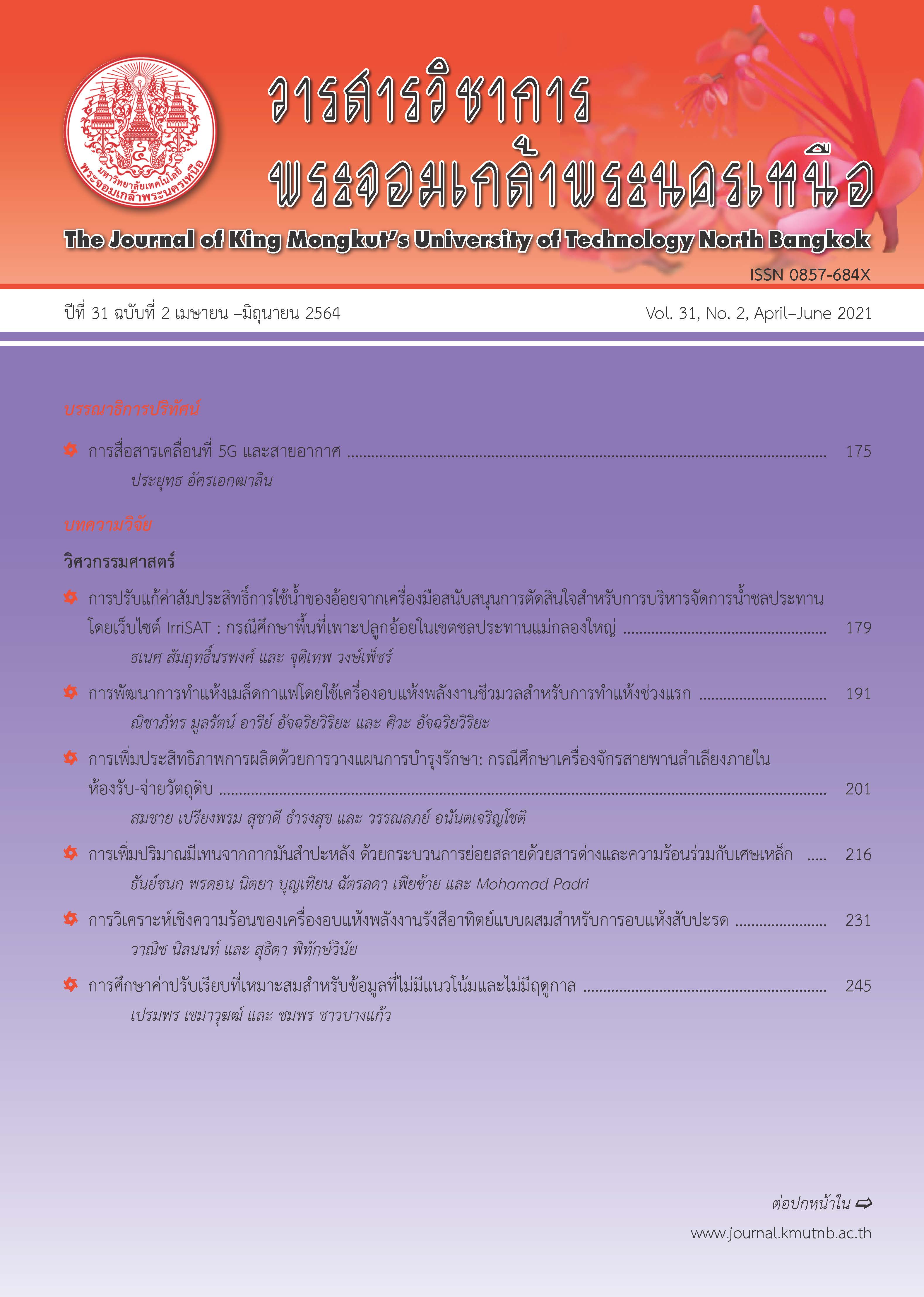การพัฒนาการทำแห้งเมล็ดกาแฟโดยใช้เครื่องอบแห้งพลังงานชีวมวลสำหรับการทำแห้งช่วงแรก
Main Article Content
บทคัดย่อ
การเก็บรักษาเมล็ดกาแฟ (เชอร์รี) หลังการเก็บเกี่ยว ควรนำเมล็ดกาแฟสดมาลดความชื้นให้เร็วที่สุด การตากแดดเป็นวิธีที่ได้รับความนิยมในประเทศที่มีแสงแดดเป็นเวลานาน การทำแห้งด้วยการตากแดดทำให้มีการถ่ายโอนรสชาติจากเนื้อของผลเชอร์รีไปที่เม็ดกาแฟด้านใน ทำให้ได้สารกาแฟที่มีรสชาติที่ดี ถ้าการทำให้แห้งไม่เร็วพอจะทำให้กาแฟมีคุณภาพต่ำลง ดังนั้นจำเป็นต้องมีการอบแห้งช่วงแรกด้วยเครื่องอบแห้งเพื่อยืดอายุการเก็บรักษา เพื่อรอกระบวนการทำแห้งด้วยแสงอาทิตย์ต่อไปบทความนี้มีวัตถุประสงค์เพื่อหาแนวทางการอบแห้งเมล็ดกาแฟสดจนเหลือความชื้นที่ปลอดภัย เพื่อการเก็บรักษาก่อนจะนำไปตากแดดและหาสมรรถนะของการอบแห้ง จากการทดลองอบแห้งโดยใช้เครื่องอบแห้งพลังงานชีวมวล โดยใช้อุณหภูมิลมร้อนเฉลี่ยในช่วง 50±1 องศาเซลเซียส ถึง 70±4 องศาเซลเซียส และใช้เวลาอบแห้งในช่วง 4 ถึง 6 ชั่วโมง ความชื้นเมล็ดกาแฟสดจะลดลงเหลือ 90% มาตรฐานแห้ง มีปริมาณน้ำอิสระเท่ากับ 0.95 ซึ่งจะมีอัตราการเติบโตของเชื้อราต่ำ ทำให้สามารถเก็บรักษาไว้ได้ในช่วงเวลาสั้นๆ ก่อนที่จะนำไปตากแดดเพื่อลดความชื้นให้เหลือ 13% มาตรฐานแห้ง นอกจากนี้ยังพบว่าความสิ้นเปลืองพลังงานจำเพาะอยู่ในช่วง 25.1–47.4 เมกะจูลต่อกิโลกรัม และประสิทธิภาพการอบแห้งอยู่ในช่วง 5.5–11.4%
Article Details
บทความที่ลงตีพิมพ์เป็นข้อคิดเห็นของผู้เขียนเท่านั้น
ผู้เขียนจะต้องเป็นผู้รับผิดชอบต่อผลทางกฎหมายใดๆ ที่อาจเกิดขึ้นจากบทความนั้น
เอกสารอ้างอิง
[2] Department of Agriculture. (2017). Strategiccoffee 2017. Horticulture Research Institute. Bangkok, Thailand [Online]. Available: http://www.doa.go.th/hort/images/jsn_is_thumbs/images/hort/strategiccoffee.pdf (in Thai).
[3] R. Buakhom, “Drying of coffee berries using heat pump and hot air,” M.S. thesis, Department of Energy Management Technology, Faculty of School of Energy and Materials King Mongkut’s University of Technology Thonburi, 2004 (in Thai).
[4] P. Uman, N. Kuakantha, and P. Umnhatkitikron, “Construction of a coffee bean solar dryer for use by agriculturists in Ban Mai Pattana, Muangpan district, Lampang,” Industrial Technology Lampang Rajabhat University Journal, vol. 5, no. 1, pp. 35–48, 2012 (in Thai).
[5] P. Nopchinwong, S. Panyatona, and S. Yousatit, “Effects of various delaying time prior to drying on Robusta bean quality,” Chumphon Horticultural Research Center Horticulture Institute, Sawi, Chumphon, 2014 (in Thai).
[6] L. M. Broissin, R. Snell, J. J. Godon, O. González, and M. L. Suárez, “Impact of storage conditions on fungal community composition of green coffee beans Coffea arabica L. stored in jute sacks during 1 year,” Journal of Applied Microbiology, vol. 124, no. 2, pp. 547–558, 2017.
[7] O. Gislaine, R. Suzana, R. Fabiana, D. Wilder, G. Maria, and R. Luis, “Influence of temperature and water activity on Ochratoxin A production by Aspergillus strain in coffee south of Minas Gerais/Brazil,” LTW-Food Science and Technology, vol. 102, pp. 1–7, 2019.
[8] P. Chunkaew, A. Tavata, A. Khadwilard, and Y. Sryudom, “Banana drying performance with a developed hot air dryer using waste heat form charcoal production process,” RMUTP Research Journal, vol. 2, no. 1, pp. 147–157, 2018 (in Thai).
[9] J. Pannawalee and S. Achariyaviriya, “Energy utilization evaluation of longan flesh dryer using biomass as fuel,” presented at the 13th Heat and Mass Energy Transfer Conference, Chanthaburi, Thailand, March 13–14, 2014 (in Thai).
[10] S. Achariyaviriya, J. Pannawalee, and A. Achariyaviriya, “Strategy for improving performance of longan flesh dryer using biomass as fuel,” presented at the 31st ME-NETT conference, Nakhonnayok, Thailand, July 4–7, 2017 (in Thai).
[11] S. Achariyaviriya, P. Chunkaew, and A. Achariyaviriya, “Development of honey bananas dryer using biomass energy,” presented at the 15th Energy Network of Thailand Conference, Nakhon Ratchasima, Thailand, May 21–24, 2019 (in Thai).
[12] N. Tippayawong, C. Tantakiti, S. Thavornun, and V. Peerawanikul, “Energy conservation in drying of peeled longan by forced convection and hot air recirculation,” Biosystems Engineering, vol. 104, no. 2, pp. 199–204, 2009.
[13] B. Khamkhoutlavong, U. Tuntiwaranuruk, and Mani M, “A thin layer drying model of Catimor coffee cherry,” Burapha Science Journal, vol. 14, no. 2, pp. 70–77, 2009 (in Thai).
[14] P. A. Berbert, D. M. Queriroz, J. S. Silva, and J. B. P. Filho, “Drying of coffee (Coffea Arabica L) in fixed bed with a simulated periodic airflow reversal,” Journal of Agricultural Engineering, vol. 59, no. 3, pp. 195–202, 1994.
[15] N. Sarppanit. (2002). Water activity and control shelf life of food products. Journal Charpa. [Online]. 9(68), pp.48–51. Available: http://www.phtnet.org/article/view-article.asp?aID=12 (in Thai).

